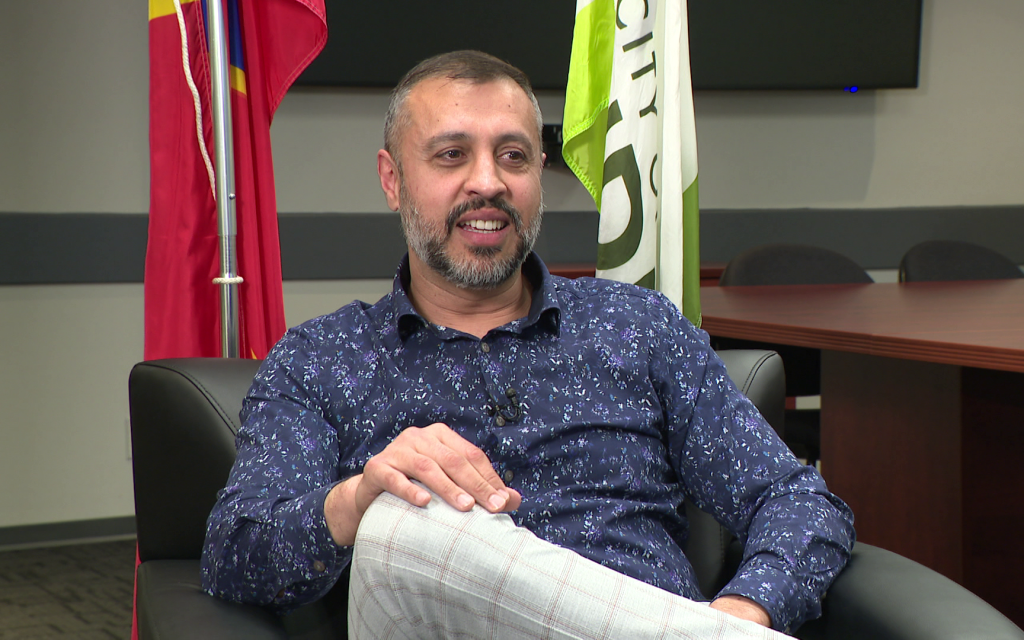The Big Story: Oh say can you Conspiracy?
Posted August 14, 2018 8:44 am.
This article is more than 5 years old.
Conspiracy theories may be a joke to most, but they’re real to a terrifying number of people. And they’re leaking off the Internet into real life.
One of the largest fires currently raging in California was allegedly started by a conspiracy theorist who believes in Pizzagate and QAnon, among other bizarre theories. Some of those theories have brought armed strangers into establishments, or led to hate campaigns that have cost people jobs.
The Internet makes it both much easier for them to spread, and much harder to disprove – and as U.S. political arguments take on the strategy of conspiracy theorist arguments, it’s only getting harder to sort truth from nonsense.
What happens to our minds that makes some of us buy in and then cling to these theories? Why doesn’t hard evidence shut them down? How can we stop theorists who are dangerously close from taking real action, and get them help?
University of Toronto psychology professor Steve Joordens joined the “Big Story” podcast to explain how what used to be simple bar chat fodder became something much more worrisome.
“I suspect conspiracy theories of a sort have been around for a long, long time. It just seems like the brain’s basic goal… making sense of partial information. So, anytime there’s a little bit of partial information out there, the mind is going to create a story — which, of course will mean different minds will create different stories.”
In this day and age, with 4K video everywhere, conspiracy theories continue to exist. Joordens said it comes down to a resistance in the human mind.
“Once it thinks it kind of understands something or has a perspective, it really likes to hold onto it… There seem to be these processes in play. One of them is called the ‘confirmation bias,’ where once we believe something to be true, then when we come into contact with new data and information, we can be incredibly selective. We kind of embrace the stuff that goes along with what we already believe and we can really downplay or sometimes fully ignore things that don’t fit what we believe. So, we have a way of not just sticking with our view, but almost strengthening our view.”
Joordens added it can be difficult to change someone’s views, especially after they’ve made them public.
You can hear the full episode and subscribe to The Big Story podcast on iTunes or Google Play.
You can also hear it online at thebigstorypodcast.ca.
So, how do people end up believing conspiracy theories in the first place?
“The example I like to give is… I’m looking out the window right now and I see — I would describe as a car that’s in front of a tree and another car that’s in front of it. So, I only see part of one car — just the back end. And I see the tree really has no trunk because it’s behind the car. In reality, what my vision is seeing is all these little bits and pieces of things. But my brain naturally puts all those things together in a way that makes sense… based on everything I know and everything I believe. It happens just effortlessly. We sometimes don’t even notice that we’re dealing with partial information, that we’ve filled in a bunch of things with assumptions. Those assumptions become as real to us as the actual data.”
Recent Big Story podcast topics:
The Big Story: Are you ready for some footb—err, politics?
The Big Story: How do you answer this question at the U.S. border?
The Big Story: When did good parenting become a crime?
However, to many people, it seems like a big jump to go from filling in the gaps with partial information to saying that since you can’t see the curvature of the Earth, that means it’s flat.
“What you then have to start doing is disputing the data. Those images from space, they are somehow concocted, or whatnot… There are some psychology studies that show people will, in fact, get extreme. One of the most interesting ones on a phenomenon called ‘cognitive dissonance.’ Dissonance is like ‘noise’ — things that don’t fit… A psychologist was going to work one day and he came into contact with this person who was saying the world was going to end… This person had a bunch of followers.”
“The world was going to end — they specified a date. And for the believers, the aliens were going to come and rescue them just before the world ended.”
Joordens said that psychologist wanted to know what the believers would do after that date and the world did not come to an end.
“The date passed, the world didn’t end, and then he interviewed these people. Many of these people sold their possessions and did the whole doomsday thing. They had bought in, big time… The day after, are they going to suddenly say, ‘I was such an idiot, why did I do this?’ What he found was that almost none of them had that attitude. In fact, their attitude was much more of, ‘Something must have gotten a little confused.’ Of course, the person that was doing the prediction ultimately got another message from the aliens that said, ‘The date was wrong. It’s going to happen again in the future.'”
He says this is an example of people who had bought into something heavily and then presented with what should be incontrovertible evidence showing they are wrong. “They will accept almost any reason to get rid of that evidence. Hang on to what they believe.”
What do conspiracy theorists gain from their beliefs?
“We don’t like to feel stupid. None of us likes to feel like idiots in any way. So, if we’ve bought into something hard and then it turns out we were an idiot for doing it, that’s a hard state. What they gain is the preservation of that sense that they’re not less intelligent than they like to think.”
Joordens cited another psychology experiment, where people were taken into a lab and asked to tap a pencil for an hour.
“Half of the people were paid $2 to tap a pencil for an hour. The other half were paid $20. At the end of the experiment, the experimenter said, ‘I’m a little busy right now. The next subject’s here. Could you please tell the next subject about the experiment for me?’ They were interested in how these two groups talked about the experiment differently.
“The $20 group essentially said, ‘You know what, this is going to be the most boring hour of your life, but you get $20.’ The $2 group said, ‘This was really fascinating. You’re going to be playing with these different rhythms and I thought I was getting better at this over time.’ They described the experiment in glowing terms. Why? Because if they didn’t, then they just wasted an hour of their life doing something stupid for $2.”
Joordens said people simply don’t like thinking they are dumb. “But if they can change the story and make the experiment interesting — including changing the story to themselves, which is critical — now, they’re not stupid. Now, they gain personal enlightenment out of it.”










